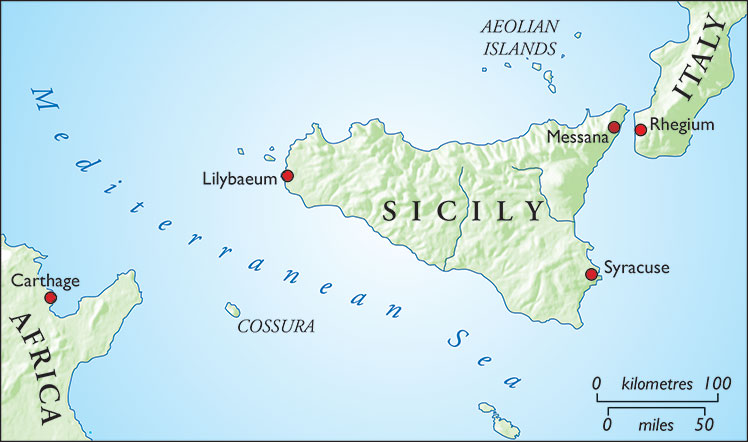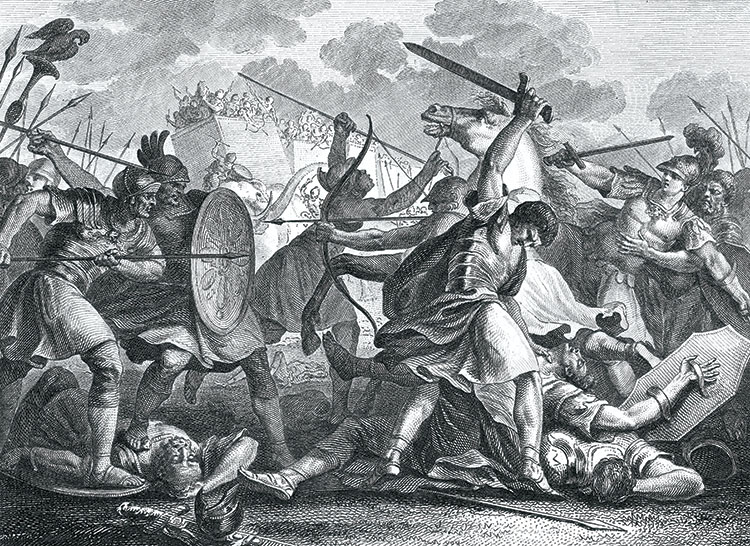Hiero II, the ruling general of the Greek city-state of Syracuse, led a campaign in 265 BC north towards a coastal Sicilian city, Messana, held by a group of Campanian mercenaries known as the Mamertines. The Campanians were part of a vast Oscan tribal group originally from the Apennine mountains, who had now settled in the southern Italian region of Campania. By the end of the fifth century BC the hill tribes had invaded the nearby plains, displacing the Etruscan and Greek inhabitants of the region, taking control of nearly all of the land between Salerno and Cumae. As the decades passed, the mountain dwellers gradually let go of their old way of life and adopted the civic lifestyle of the people they had conquered. The newly sedentary Campanians appealed to the Romans for their help against their aggressive neighbours, the Samnites. In 343 BC Rome came to their aid and, in turn, the Campanians became subjects of the Republic. From then on the Campanians were considered civites sine suffragio, meaning they had all of the privileges of Roman citizens but without the right to vote in Rome.
Regardless of their new status as subjects under Roman hegemony, the Campanians, and in particular the Mamertines, never relinquished their martial skills. In fact, the two major powers in Sicily, the Carthaginians and the island’s Greek city-states, had relied on southern Italy as a plentiful source of mercenaries ever since the Oscan peoples seized the Campanian plain. They continued to do so in the centuries that followed, as they continuously fought each other over domination of the island. For decades, the foreign soldiers had raided and pillaged the entire region both by land and sea. As the ruler of the most powerful city of eastern Sicily, Syracuse, Hiero II would not tolerate the mercenaries any longer and, by the middle of the third century, had the necessary resources to end their constant piracy. When he confronted the Mamertines near the River Longanus, his forces crushed them. The few surviving Mamertines fled to safety and debated what to do next. The fear of future attacks had caused so much panic that they turned to the most powerful empire of the western Mediterranean, Carthage, as well as the Roman Republic to save them from Hiero.
In doing so, the Mamertines sparked one of the most significant wars of the ancient Mediterranean, the First Punic War (264-241 BC), becoming some of the most notorious and renowned mercenaries of the classical world.
 Locations of the major battles fought by the Sons of Mars.
Locations of the major battles fought by the Sons of Mars.
Near the end of the fourth century BC, Agathocles, the new tyrant of Syracuse and a Sicilian warlord, had recruited a substantial number of Campanian mercenaries. From the moment Agathocles had seized power in 317 BC, the former soldier had employed mercenaries and continued to do so throughout his entire reign, as he established a powerful empire in eastern Sicily. As Agathocles warred with the Carthaginians and rival Greek city-states to take control of the entire eastern half of the island, he had added the city of Messana to his possessions some time between 315 and 312 BC.
When Agathocles was 72, in 289 BC, the self-proclaimed king of Syracuse and Sicily was assassinated by members of his own family, following arguments surrounding his succession. After his death, the large group of Campanian mercenaries he had hired clashed with the Syracusan citizenry. To convince the Italian soldiers to leave, the Syracusans offered them the conquered city of Messana, which they quickly accepted. A year later, in 288 BC, the citizens of Messana allowed the mercenaries to enter their city only to regret their decision shortly after. Once inside, the foreign troops slaughtered the men, enslaved the women and seized the city. From then on, the mercenaries called themselves the Mamertines, or ‘the sons of Mamers’, the name for the war-god Mars in the Oscan language of the Campanians.
Due to the near constant influx of Campanian mercenaries into Sicily for over a century, this was not the first time that foreign soldiers had seized a city on the island. For instance, Campanians took the western Sicilian city of Entella in 404 BC. However, the degree to which the Mamertines devoted themselves to violence and warfare, as they either intimidated their neighbours into giving them tribute or took their possessions by force, quickly made them notorious throughout the region. By the end of the third century BC, the self-styled ‘Sons of Mars’ had sacked and pillaged as far as Gela and Camarina along the southern coast of Sicily.
While the Sons of Mars were a terrible irritation, many of the Greek city-states of Sicily still considered the Carthaginian Empire as their main threat, especially the people of Syracuse. Therefore, after a large Carthaginian army had besieged the city once again, Syracuse and the Hellenistic community of Sicily chose a new champion to defend them: King Pyrrhus of Epirus. At the time, the general was fighting a war with the Romans on behalf of a Greek city in southern Italy, Tarentum. Even though he had achieved two victories over the armies of the Republic, the loss of his soldiers had been so great that the ambitious king decided to abandon the Tarentines and heed the call of the Sicilian Greeks, believing that the Carthaginians would be an easier foe to overcome.
Pyrrhus arrived in Sicily in 278 BC and began his conquest of the island. However, only two years later, he had failed to accomplish this goal, as he could not capture the formidable Carthaginian stronghold of Lilybaeum. His failure was mostly due to the fact that the Sicilian Greeks had turned against him for his increasingly autocratic conduct towards them. Throughout Pyrrhus’ Sicilian campaign, the Mamertines had been allied with the Carthaginians against the Hellenistic general. So, even though the king of Epirus attacked and defeated the mercenaries, the Sons of Mars managed to retain Messana and their independence. When the Greeks of Sicily had completely risen against their denounced, prior saviour, many of them even wanted the Carthaginians or the Mamertines to then save them from Pyrrhus. The aspiring king of Sicily withdrew from the island in the autumn of 276 BC and returned to Italy to fight Rome for Tarentum once again. Pyrrhus lost the Battle of Benevento in 275 BC, putting an end to all of his campaigns west of Epirus. This final withdrawal from Italy of the Hellenistic commander greatly benefited the Romans, who were then free to conquer Tarentum in 272 BC, along with the rest of the Italian south, previously controlled by the Greeks.
While the Romans were preoccupied with Pyrrhus and Tarentum, they were unable to deal with a volatile situation for which they were partly to blame concerning the actions of another group of dangerous Campanian soldiers. When Pyrrhus invaded Italy for Tarentum, the citizens of Rhegium panicked and, because of their alliance with the Roman Republic, immediately called for Rome to send sufficient aid for a proper defence of the city. For its strategic location on the south-western tip of Italy, with only the narrow Straits of Messana separating it from Sicily, Rhegium was a pivotal ally and the Romans quickly obliged.
Under the command of an officer named Decius, the Romans sent a garrison of 4,000 Campanian soldiers to the city. Just as the Sons of Mars had done a decade before, these Campanian troops also attacked the citizenry after the city gates were opened freely to them. But this time the Campanians did not massacre all of the male citizens; those who were not killed were instead forced into exile. Furious over their soldiers’ treatment of one of their allies, the Republic took action. After the capture of Tarentum, Roman soldiers besieged Rhegium in 271 BC. A year later, the Roman army broke through the city’s defences and the remaining 300 Campanians left alive were taken captive. In the heart of the capital, the Roman Forum, the treasonous soldiers were flogged and decapitated.
 Pyrrhus faces defeat at the Battle of Benevento, 19th-century engraving. Mary Evans Picture Library
Pyrrhus faces defeat at the Battle of Benevento, 19th-century engraving. Mary Evans Picture Library
With the threat of Pyrrhus gone, the mercenaries returned to marauding. The Sons of Mars managed to conquer a substantial portion of north-eastern Sicily, creating an empire whose territory stretched from Mount Etna in the south and as far west as Halaesa on the north coast. The foreign pirates had now become too great a threat for Syracuse to ignore. After the next tyrant took control of the city and reorganised the army to include a new native militia force alongside the conventional contingent of mercenaries, a truce was established with the Carthaginian Empire to deal with the Mamertines. Hiero II was one of the most loyal supporters of Pyrrhus within Syracuse and managed to retain his high position in the city even after the king had retreated from the island. At first, his position in the city was limited for he was only acknowledged as Strategus, the overall commander of the army. It was only after the general confronted the Mamertines for the first time at the victorious battle of the River Cyamosorus in 269 BC, that he was able to secure complete control of Syracuse and, the following year, take the title of Strategus Autocrator.
As an autocratic ruler with full powers, Hiero primarily focused on stabilising the city in the anarchic period following the assassination of Agathocles. The tyrant was then free to focus on striking his fatal blow against the Mamertines. With fewer than 12,000 soldiers, Hiero invaded north-eastern Sicily in 265 BC. As the campaign progressed a stalemate ensued. The Sons of Mars were unable to drive off the invaders competely and Hiero could not definitively defeat them either. Then in the spring of 264 BC the two forces met on the plains of Mylae near the River Longanus. On the battlefield the blessing of the war god was kept from his devoted followers and bestowed instead on their enemies, as Hiero’s Syracusan army annihilated the Sons of Mars.
























